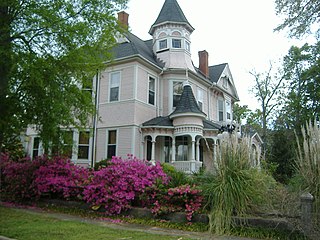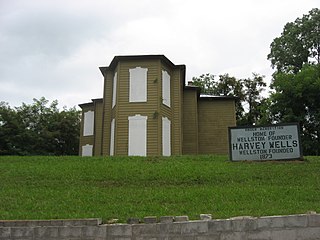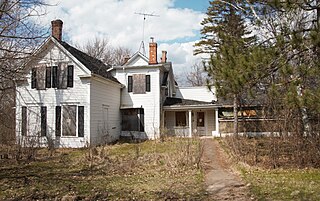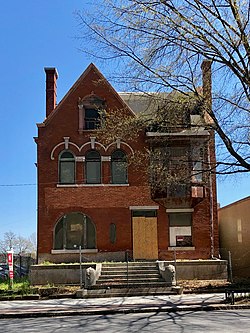A historic house generally meets several criteria before being listed by an official body as "historic." Generally the building is at least a certain age, depending on the rules for the individual list. A second factor is that the building be in recognizably the same form as when it became historic. Third is a requirement that either an event of historical importance happened at the site, or that a person of historical significance was associated with the site, or that the building itself is important for its architecture or interior. Many historic houses are also considered museums and retain permanent collections that help tell the story of their house and the era.

Midtown Atlanta, or Midtown, is a high-density commercial and residential neighborhood of Atlanta, Georgia. The exact geographical extent of the area is ill-defined due to differing definitions used by the city, residents, and local business groups. However, the commercial core of the area is anchored by a series of high-rise office buildings, condominiums, hotels, and high-end retail along Peachtree Street between North Avenue and 17th Street. Midtown, situated between Downtown to the south and Buckhead to the north, is the second-largest business district in Metro Atlanta. In 2011, Midtown had a resident population of 41,681 and a business population of 81,418.

The Margaret Mitchell House is a historic house museum located in Atlanta, Georgia. The structure was the home of author Margaret Mitchell in the early 20th century. It is located in Midtown, at 979 Crescent Avenue. Constructed by Cornelius J. Sheehan as a single-family residence in a then-fashionable section of residential Peachtree Street, the building's original address was 806 Peachtree Street. The house was known as the Crescent Apartments when Mitchell and her husband lived in Apt. 1 on the ground floor from 1925 to 1932. While living there, Mitchell wrote the bulk of her Pulitzer Prize-winning 1936 novel, Gone with the Wind.

The Governor's Mansion is the official home of the governor of the U.S. state of Georgia. The mansion is located at 391 West Paces Ferry Road NW, in the Tuxedo Park neighborhood of the affluent Buckhead district of Atlanta.
The Kimball House was the name of two historical hotels in Atlanta, Georgia. United States. Both were constructed on an entire city block at the south-southeast corner of Five Points, bounded by Whitehall Street, Decatur Street, Pryor Street, and Wall Street, a block now occupied by a multi-story parking garage.

Rhodes Memorial Hall, commonly known as Rhodes Hall, is a historic house located in Atlanta, Georgia, United States. It was built as the home of furniture magnate Amos Giles Rhodes, proprietor of Atlanta-based Rhodes Furniture. The Romanesque Revival house occupies a prominent location on Peachtree Street, the main street of Atlanta, and is listed in the National Register of Historic Places. It is open to the public and has been the home of The Georgia Trust for Historic Preservation since 1983.

The Dyckman House, now the Dyckman Farmhouse Museum, is the oldest remaining farmhouse on Manhattan island, a vestige of New York City's rural past. The Dutch Colonial-style farmhouse was built by William Dyckman, c.1785, and was originally part of over 250 acres (100 ha) of farmland owned by the family. It is now located in a small park at the corner of Broadway and 204th Street in Inwood, Manhattan.

SoNo is a sub-district of downtown Atlanta, Georgia, just south of Midtown. The area was defined and named by T. Brian Glass while working on a rezoning committee with Central Atlanta Progress in 2005 in order to better establish an identity for the area and give it a hipper image. SoNo refers to the area of Downtown bounded by North Avenue on the north, Central Park Place on the east and the Downtown Connector (Interstate-75/85) on the west and south.

The Emil Bach House is a Prairie style house in the Rogers Park neighborhood of Chicago, Illinois, United States that was designed by architect Frank Lloyd Wright. The house was built in 1915 for an admirer of Wright's work, Emil Bach, the co-owner of the Bach Brick Company. The house is representative of Wright's late Prairie style and is an expression of his creativity from a period just before his work shifted stylistic focus. The Bach House was declared a Chicago Landmark on September 28, 1977, and was added to the U.S. National Register of Historic Places on January 23, 1979.

The Herndon Home is a historic house museum and National Historic Landmark at 587 University Place NW, in Atlanta, Georgia. An elegant Classical Revival mansion with Beaux Arts influences, it was the home of Alonzo Franklin Herndon (1858-1927), a rags-to-riches success story who was born into slavery, but went on to become Atlanta's first black millionaire as founder and head of the Atlanta Life Insurance Company. The house was designed by his wife Adrienne, and was almost entirely built with African-American labor. The house was declared a National Historic Landmark in 2000, and had previously been declared a "landmark building exterior" by the city of Atlanta in 1989.

The Elson-Dudley House is a historic home located at 1101 29th Avenue, Meridian, Mississippi. Built in 1894 by Julius and Dora Neubauer Elson, some of Meridian's earliest settlers, the home is a Victorian Eastlake movement home with Queen Anne influence. The home was listed on the National Register of Historic Places on December 18, 1979, under the Meridian Multiple Property Submission. It is also part of Merrehope Historic District, which was listed on the National Register on September 19, 1988.

The Clayton-Cedarmere Estates are located in Roslyn Harbor, New York, United States, listed jointly on the National Register of Historic Places in 1986. Clayton, the bulk of the property, is the large landscaped Bryce/Frick estate, now home to the Nassau County Museum of Art. Cedarmere, the smaller of the two, is William Cullen Bryant's estate, currently undergoing interior renovation, is located on the west side of Bryant Avenue; overlooking Hempstead Harbor, now a historic house museum. The grounds are open to the public. The two combined properties, with input from several notable architects, illustrate the development of estates on the North Shore of Long Island over a period of nearly a century.

Lemon Hill is a Federal-style mansion in Fairmount Park, Philadelphia, built from 1799 to 1800 by Philadelphia merchant Henry Pratt. The house is named after the citrus fruits that Pratt cultivated on the property in the early 19th century.

Rose Hill Manor, now known as Rose Hill Manor Park & Children's Museum, is a historic home located at Frederick, Frederick County, Maryland. It is a 2+1⁄2-story brick house. A notable feature is the large two-story pedimented portico supported by fluted Doric columns on the first floor and Ionic columns on the balustraded second floor. It was the retirement home of Thomas Johnson (1732–1819), the first elected governor of the State of Maryland and Associate Justice of the United States Supreme Court. It was built in the mid-1790s by his daughter and son-in-law.

The New York Landmarks Conservancy is a non-profit organization "dedicated to preserving, revitalizing, and reusing" historic structures in New York state. It provides technical and financial skills to owners of historic properties. In the half century since its 1973 founding, the conservancy has provided more than $60 million in grants and loans.

The Harvey Wells House is a historic residence in the city of Wellston in the southern part of the U.S. state of Ohio. Built in 1883, it was the home of Harvey Wells, a local entrepreneur who founded the city of Wellston in the 1870s with the goal of making it into the region's leading metropolis. Located on the A Street Hill, the house occupies one of the highest points in the city of Wellston.

Willis F. Denny (1874-1905) was an architect active in Atlanta, Georgia around the turn of the twentieth century. He was the architect of Rhodes Hall (1903) and the Kriegshaber House, both listed on the National Register, as well as the demolished Piedmont Hotel (1903).

Rufus Mathewson Rose, was an American businessman. After growing up and receiving a primary and secondary education in that state, he moved to New York City, where he practiced as a druggist, and then on to Long Island, where he worked in a sailors' hospital.

Hotel Indigo Atlanta Midtown is a historic building in midtown Atlanta, Georgia. Designed by Atlanta-based architectural firm Pringle and Smith in 1925, the brick building is located on Peachtree Street, across from the Fox Theatre. It has been listed on the National Register of Historic Places since 2006, and, in 2022, is a member of Historic Hotels of America.

The Tobias G. Mealey House is a historic house in Monticello, Minnesota, United States. Its original section was built in 1855 by Tobias Mealey (1823–1904). The Mealey family made numerous additions to the house throughout the latter 19th century, and later owners added a large wing to the east. The house was listed on the National Register of Historic Places in 1976 for having local significance in the themes of commerce, exploration/settlement, and politics/government. It was nominated for its association with Mealey, an influential local settler, entrepreneur, and politician. It was delisted in 2020.
























